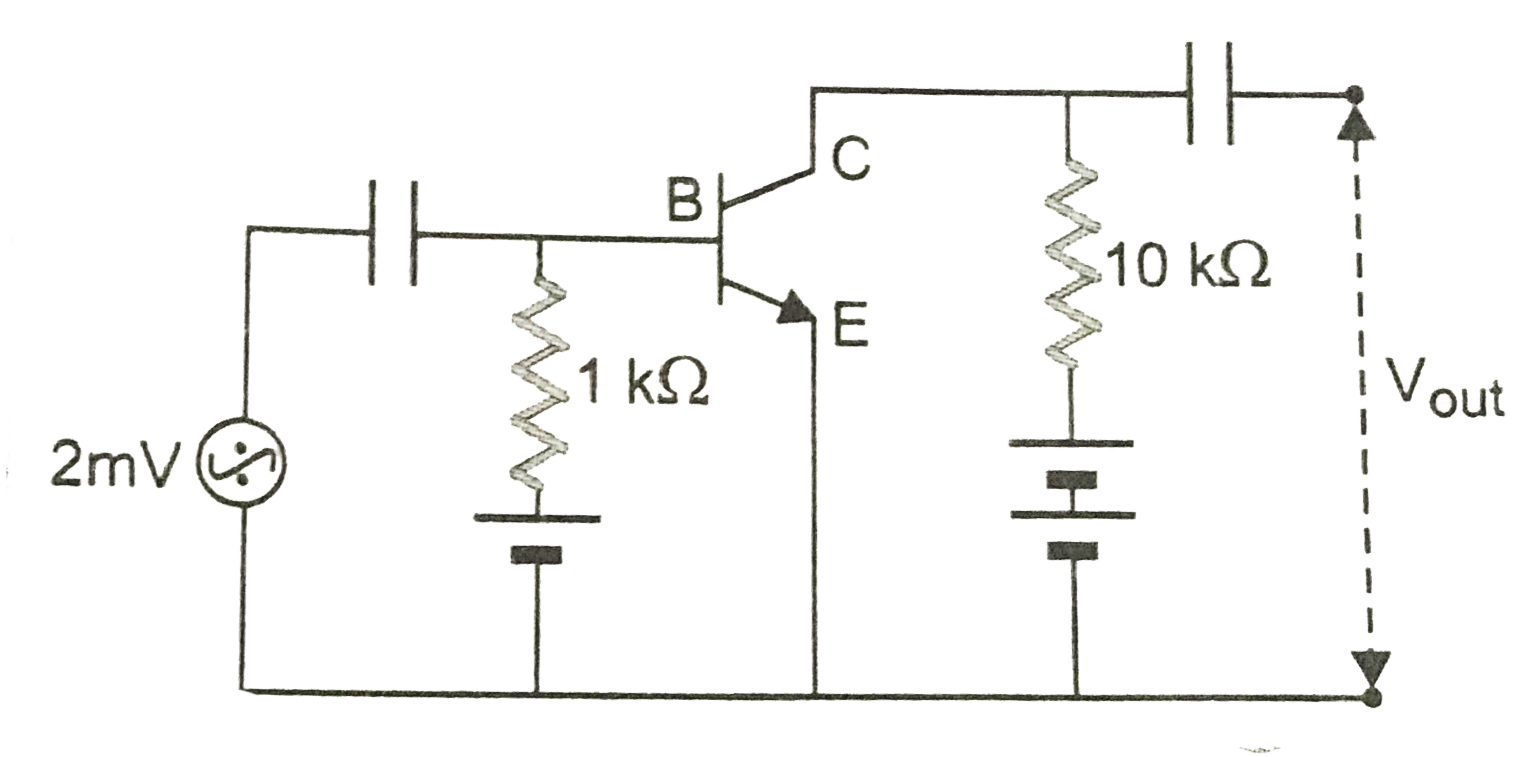A transistor is being used as a common emitter amplifier .
a What is the phase relationship between the output and input voltages ?
b. Define voltage gain of an amplifier.
c. Define the transconductance of a transistor . Solution in Tamil
a. A phase change π is introduced between the input and output signal .
b. Voltage gain , AV of a transistor amplifier is the ratio of O/P voltage (Vo) to I/P voltage (Vi).
AV=VoVi=−ΔIC.RLΔVBE=β(RoRi)
c. Transconductance , gm is the ratio of change in collector current to the change in the base-emitter voltage .
i.e, gm=ΔLCΔVBE Also , gm=|AV|RL
Topper's Solved these Questions
- BOOK - NEW JOYTHI PUBLICATIONCHAPTER - SEMICONDUCTOR ELECTRONICS : MATERIALS , DEVICES AND SIMPLE CIRCUITS EXERCISE - CONTINUOUS EVALUATION (ASSIGNMENT)7videos
SEMICONDUCTOR ELECTRONICS : MATERIALS , DEVICES AND SIMPLE CIRCUITS
- BOOK - NEW JOYTHI PUBLICATIONCHAPTER - SEMICONDUCTOR ELECTRONICS : MATERIALS , DEVICES AND SIMPLE CIRCUITS EXERCISE - PREVIOUS YEAR QUESTIONS3videos
SEMICONDUCTOR ELECTRONICS : MATERIALS , DEVICES AND SIMPLE CIRCUITS
- BOOK - NEW JOYTHI PUBLICATIONCHAPTER - SEMICONDUCTOR ELECTRONICS : MATERIALS , DEVICES AND SIMPLE CIRCUITS EXERCISE - PRACTICE PROBLEMS FOR SELF ASSESSMENT8videos
SEMICONDUCTOR ELECTRONICS : MATERIALS , DEVICES AND SIMPLE CIRCUITS
- BOOK - NEW JOYTHI PUBLICATIONCHAPTER - RAY OPTICS AND OPTICAL INSTRUMENTS EXERCISE - COMPETITIVE EXAM CORNER26videos
RAY OPTICS AND OPTICAL INSTRUMENTS
- BOOK - NEW JOYTHI PUBLICATIONCHAPTER - WAVE OPTICSEXERCISE - COMPETITIVE EXAM CORNER17videos
WAVE OPTICS
Similar Questions
On the basis of band theory , explain the difference between conductor , insulator and semiconductor.
02:48View SolutionWe are familiar with the semi conductors Silicon and Germanium .
a. With a necessary schematic diagram , briefly explain the characteristics of an intrinsic semiconductor.
b. Draw the energy bands of a n-type semiconductor.
c The following figure represents a
d . Draw a typically illuminated P-n junctions solar cell.
e. LED convert............ energy to light.02:42View SolutionA semiconductor has the electron concentration 0.45×1012m−3 and hole concentration 5×1029m−3 . Find its conductivity . Given electron mobility = 0.135m2V−1s−1 and hole mobility = 0.048m2V−1s−1,e=1.6×10−19C
04:12View SolutionA 100 W bulb produces an electric field of 2.9 V/m at a point 3m away. If the bulb is replaced by 400 W bulb without disturbing other conditions. Then the electric field produced at the same point is
09:51View SolutionYoung's experiment is performed with light of wavelength 6000Å where in 16 frignes occupy a certain region on the screen. If 24 fringes occupy the same region with another light of wavelength λ then λ is
00:59View SolutionWhat is the phase relationship in the output and input voltage in the common base transistor amplifier.
04:29View SolutionIn the common emitter amplifier circuit, Fig. an npn transistor with output voltage of the amplifier as 1 V, the current gain of transistor amplifier is :
 02:45View Solution
02:45View SolutionIn common emitter transistor amplifier circuit, the input signal voltage and the output collector voltage are ..............phase.
02:45View SolutionWith the help of a labelled circuit diagram, explain how an n-p-n transistor can be used as an amplifier in common-emitter configuration. Explain how the input and output voltages are out of phase by 1800 for a common-emitter transistor amplifier.
01:12View SolutionIn a common emitter amplifier circuit using an n-p-n transistor, the phase difference between the input and the output voltages will be:-
00:59View SolutionIn a common-emitter amplifier circuit using an n-p-n transistor the phase differene between the input and the output voltages will be
06:57View SolutionWhat is the phase relationship between the AC input and output voltages in a common emitter amplifier ? What is the reason for the phase reversal ?
View SolutionWhat is the phase relationship between the AC input and output voltages in a common emitter amplifier ? What is the reason for the phase reversal ?
View SolutionIn a common emitter amplifier circuit using a n-p-n transistor, the phase difference between the input and the output voltages will be ……..
View SolutionIn a common emitter amplifier circuit using an n-p-n transistor, the phase difference between the input and the output voltages will be:-
View Solution

